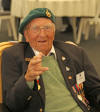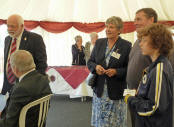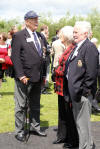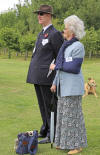73 years on, the great achievements and
sacrifices of all who served in the Command, or alongside it on
amphibious operations, were publicly recognised for the first time as
a unified force drawn from the Army, Navy and Air Force.
Arrival/Marquee
Coffee, tea and biscuits were provided
from 12 noon in the Arboretum's marquee, adjacent to the visitor centre.
It was a welcome opportunity to recover from the journey, to exchange
news and information with other guests and to meet e-mail friends for
the first
time. Veterans were soon engaged in animated chat, as they recalled
events of 70 years earlier.
All guests received a detailed programme
of the day's events and on cue, at 1 o'clock, they made their way down
to the memorial site. Scooters and golf style buggies transported the
less ambulant.
The Official Party comprised Her Majesty's
Lord Lieutenant of Staffordshire, Mr Ian Dudson, CBE and his wife Jane,
General Sir Richard Barrons, KCB
CBE ADC
Commander of the Joint Forces Command,
Military Artist, David Thorp and his wife, Olwen, the Reverend
Prebendary Tony Wood and Geoffrey Slee, organiser of the event and his wife, Margaret.










































Memorial Site
By the time the official party
arrived at 1.30 pm, everyone with a job to do was in place, including 6
Standard Bearers, a piper and a bugler. Seating was neatly arranged in
a cosy L shape.



























Dedication & Unveiling
Proceedings were opened
by event organiser, Geoff Slee, with a warm welcome and a brief
history of the Combined Operations website and memorial projects.
Around £15,000 had been raised through donations and fund raising
initiatives, of which around £13,300 was spent on the construction of
the memorial.
He explained that there was a high level of symbolism in the design of
the memorial.
The spearhead shape reflected the attack formation adopted on
Commando raids and major landings, with the apex representing the
initial assault troops, who faced the brunt of the enemy’s coastal
defences, the remainder of the triangle representing the follow on invading
force after the beachhead had been secured, and the shaft representing
the reserve forces.
The 3 standing stones and the 3 trees represented
the 3 services - oak for the Navy, ash for the Army and Sitka spruce
for the RAF; timber used by each of the services in the past. All the
stones came from the shores of Loch Fyne in Scotland, where 250,000
personnel from the 3 services trained together in amphibious landings,
using a variety of landing craft.
The WW2 pillbox in the background and close proximity of the
River Tame provided additional ambiance to the tranquil setting - water and defensive gun
positions.
General Barrons provided a brief
history of the Combined Operations Command from the prickly
relationship Sir Roger Keyes, Director of Combined Operations, had with the Chiefs of Staff, through the
Mountbatten years to the end of the war and beyond, under the
stewardship of General Laycock. The role of the present day Joint
Forces Command was, of course, very different but there was much affinity
between the two commands as the wearing of the Combined Operations
badge by some units of the Joint Forces Command, testified.
Click
here to read General Barrons' speech.
Lord Lieutenant Dudson reminded
everyone that the Combined Operations Command website would remain the
educational component of the memorial, while a demand existed for the
information it contained. The website was visited by 250,000 people
each year, recording millions of hits. With the advent of mobile phones
and computer tablets, it would soon be possible to see what the
memorial represents from the Combined Operations website, while visiting the
memorial.














Laying of Wreaths & Other Tributes
HM Lord Lieutenant for Staffordshire
laid the first wreath, followed by General Barrons. Two great
grandchildren of RAF Combined Ops veteran, John Glen, laid the next
wreath on behalf of all who supported the memorial fund. It was John
Glen's reminiscences of his service in the Combined Operations Command that
planted the seed from which grew the Combined Operations Command
website. It was first published in 2000 and the Combined Operations Memorial Fund
set up in 2005.
Wreaths and other tributes laid
by veterans, their families and friends, provided the most emotional
and poignant part of the ceremony. Many a tear was shed as thoughts
turned to absent comrades and loved ones. Much courage, determination
and dignity was on display that afternoon.
They shall not grow
old, as we that are left grow old: Age shall not weary them, nor the
years condemn. At the going down of the sun and in the morning, we
will remember them.




















When you go home,
tell them of us and say - for your tomorrow we gave our today.

Acknowledgements
For their help on the day, thanks are due
to Brenda Gordon and Elizabeth Hall (reception desk), Ken Hope, Ann
Hope, Mike Phillips and Sheila Phillips (marquee reception and name
badges), Mike Hall (MC/trouble-shooter), Colin Gillespie (arrangements
at the memorial site), David Thorp (VIP greeter), Richard Stimpson
(organisation of standard bearers),
Harriet Calfo (official photographer) with
additional photos by Mike Wright, Pam Wright and Sarah Slee. The general
factotum was David Slee. Thanks also to Mike McKenna (Piper),
Adrian Harper (Bugler) and the six
standard bearers, whose presence greatly honoured and respected all
veterans who served in or alongside the Combined Operations Command.
Thank you so much for the many e-mail
messages, letters, cards and phone calls.
The memorial is in the grounds of the
National Memorial Arboretum (NMA) around 27 miles north, north east of
Birmingham near the village of Alrewas, Staffordshire. For SatNav
use
DE13 7AR.
The GPS
coordinates are; Lat N 52 43.705 and Long W 1 43.934. The
coordinates
of the memorial within the NMA grounds are; Lat N 52 43.866 and Long
W 1 43.360.
There's more information on
planning your visit on this page.
Kindest regards
Geoffrey Slee
Combined Operations Memorial Fund










































































































